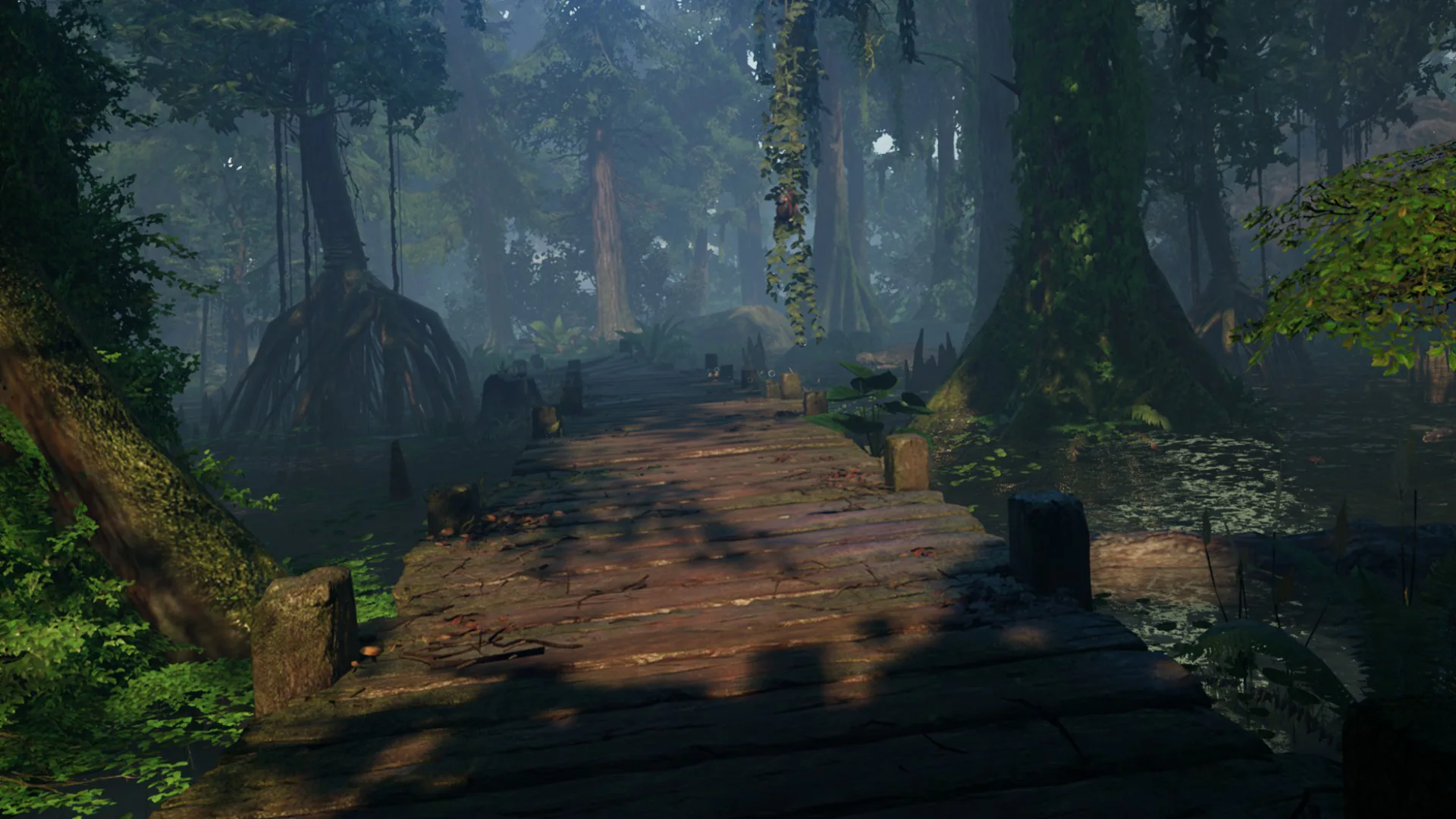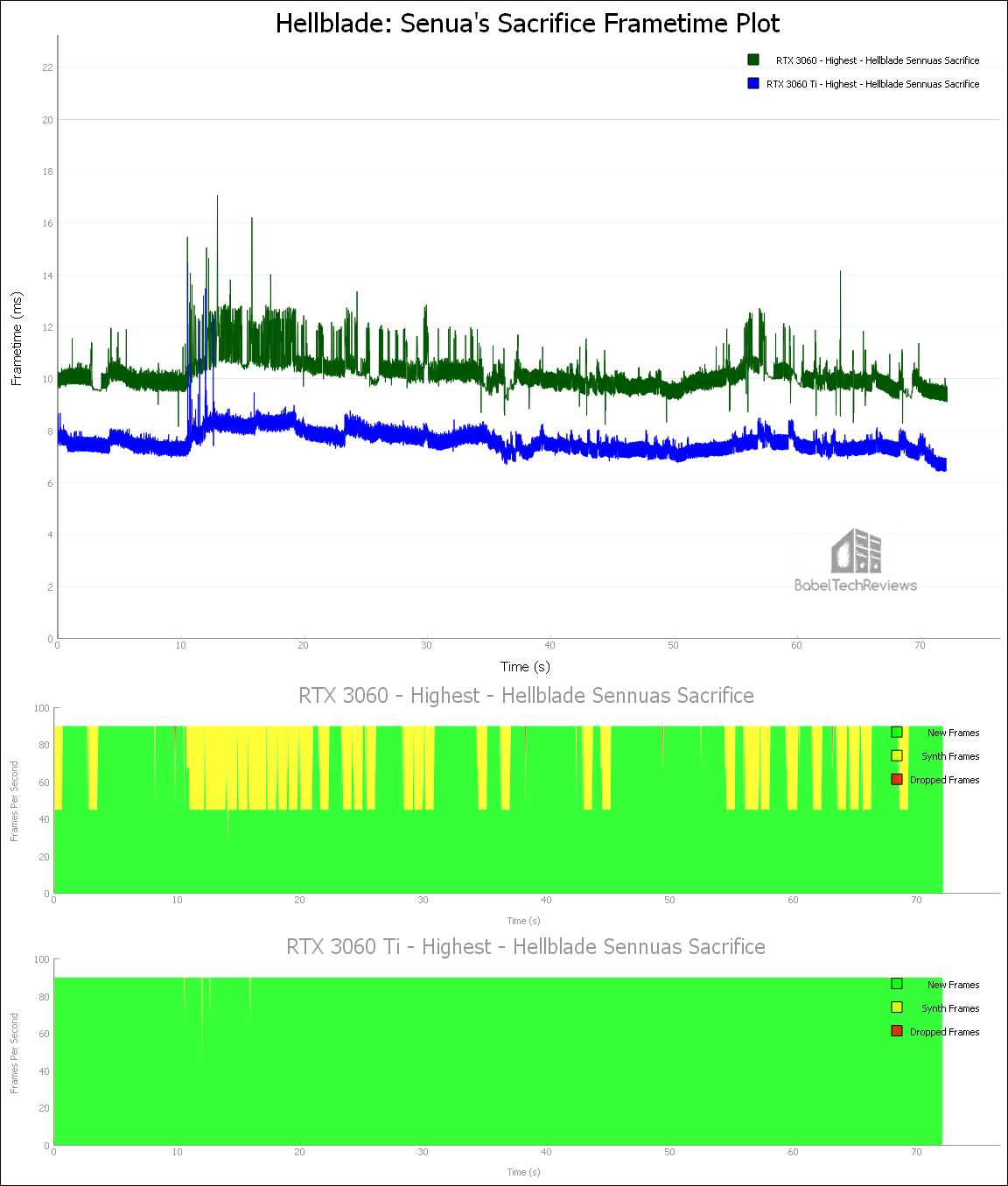The Mega 50+ Game EVGA RTX 3060 Black Launch Review – Part 1, VR
The RTX 3060 has arrived as the EVGA Black since there is no Founders Edition, and we will benchmark this midrange video card for virtual reality to compare performance with its faster sibling, the RTX 3060 Ti, that we recommended as the new “bang for buck” VR champ. This review presents its performance in 16 VR games using the Vive Pro and FCAT VR. We will follow up later today with Part 2 of BTR’s mega review using 37 regular games, GPGPU, workstation, SPEC, and synthetic benchmarks comparing the new card’s performance with the RTX 3060 Ti, the RTX 2060, the GTX 1060, and against the Radeon RX 5700 XT. 
In pancake games, depending on resolution, the $329 RTX 3060 is about 30% slower than the $399 RTX 3060 Ti, and about 25% faster than the Turing GeForce RTX 2060 which launched originally at $349. It’s also on average 90% faster than the Pascal GeForce GTX 1060 which was one of NVIDIA’s most popular cards that launched at the bargain price of $249 four and one-half years ago. The RTX 3060 is also about as fast as the Radeon RX 5700 XT which launched at $449, but we test using the Anniversary Edition which originally launched at $499.
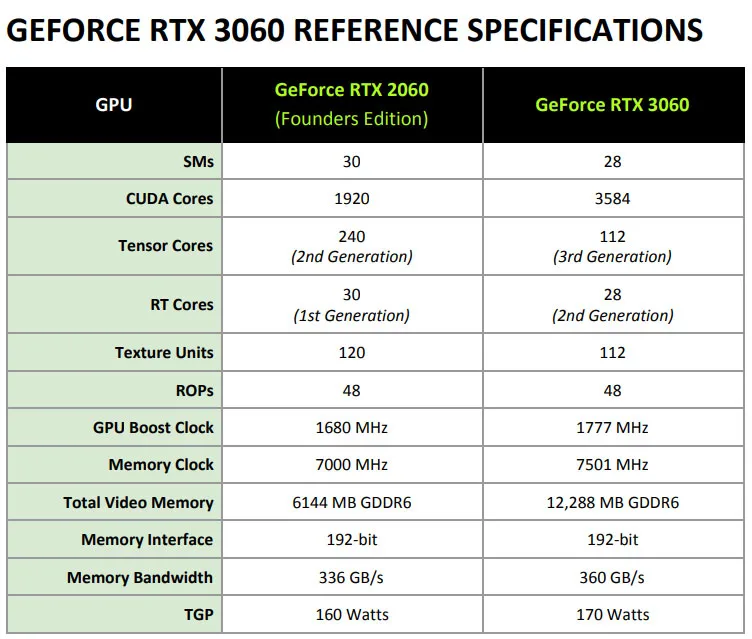
The RTX 3060 delivers 12.7 shader TFLOPs, 24.9 RT TFLOPs, and 102 Tensor TFLOPs (using the new sparsity feature) of computational power over a 192-bit memory interface using 12GB of GDDR6. It is based on its own 12 billion transistor GA106 chip, not the GA104 chip used in the RTX 3060 Ti and for the RTX 3070.
We want to see where the RTX 3060 fits regarding VR performance and how it compares with the RTX 3060 Ti which is sufficient to power a headset of the Valve Index/Vive Pro class. We had originally planned to also compare its performance with the RTX 5700 XT, but the latest driver caused conflicts with SteamVR that we were unable to solve in time for this review. Although a fast CPU is important for geometry and other processing, smooth VR delivery depends mostly on the video card. An underpowered video card can even cause reprojecting and artifacting for a substandard playing experience that can even lead to VR sickness.
We currently benchmark sixteen VR games using the Vive Pro that features 2880×1600 resolution (1440×1600 pixels per eye), the same as the Valve Index and with similar performance at 90Hz/90FPS. BTR’s testing platform is an overclocked Intel Core i9-10900K, an EVGA Z490 FTW motherboard, and 32 GB of Vulcan Dark Z DDR4 at 3600MHz on a clean install of Windows 10 64-bit Pro Edition using the RTX 3060 launch driver, 461.64.
It is important to be aware of VR performance since poorly delivered frames can make a VR experience unpleasant. It’s also important to understand how we accurately benchmark VR games using FCAT-VR as explained here. But before we benchmark our VR games, check out our Test Configuration below.
Test Configuration – Hardware
- Intel Core i9-10900K (HyperThreading/Turbo boost On; All cores overclocked to 5.1GHz/5.0Ghz. Comet Lake DX11 CPU graphics)
- EVGA Z490 FTW motherboard (Intel Z490 chipset, v1.3 BIOS, PCIe 3.0/3.1/3.2 specification, CrossFire/SLI 8x+8x), supplied by EVGA
- T-FORCE DARK Z 32GB DDR4 (2x16GB, dual channel at 3600MHz), supplied by Team Group
- Vive Pro, on loan from HTC/Vive; the Wireless Adapter is not used for benchmarking
- RTX 3060 Founders Edition 12GB, stock clocks, on loan from EVGA
- RTX 3060 Ti Founders Edition 8GB, stock clocks, on loan from NVIDIA
- Radeon RX 5700 XT 8GB, Anniversary Edition, at AE clocks (Adrenalin Edition 21.2.3 drivers).
- 1TB Team Group MP33 NVMe2 PCIe SSD for C: drive
- 1.92TB San Disk enterprise class SATA III SSD (storage)
- 2TB Micron 1100 SATA III SSD (storage)
- 1TB Team Group GX2 SATA III SSD (storage)
- 500GB T-FORCE Vulcan SSD (storage), supplied by Team Group
- ANTEC HCG1000 Extreme, 1000W gold power supply unit
- BenQ EW3270U 32? 4K HDR 60Hz FreeSync monitor
- Samsung G7 Odyssey (LC27G75TQSNXZA) 27? 2560×1440/240Hz/1ms/G-SYNC/HDR600 monitor
- DEEPCOOL Castle 360EX AIO 360mm liquid CPU cooler
- Phanteks Eclipse P400 ATX mid-tower (plus 1 Noctua 140mm fan)
Test Configuration – Software
- GeForce 461.64 press RTX 3060 launch drivers – High Quality, prefer maximum performance, single display, no optimizations, Vsync is off as set in the NVIDIA control panel
- Windows 10 64-bit Pro edition; latest updates v2004.
- Latest DirectX
- All 16 VR games are patched to their latest versions at time of publication
- FCAT-VR Capture Beta 03/04/20
- FCAT-VR Beta 18
- SteamVR – at 100% resolution unless specified
16 VR Game benchmark suite & 3 synthetic tests
Synthetic
- VRMark Blue Room
- Unigine Superposition VR Benchmark
- OpenVR Benchmark
SteamVR /Epic Platform Games
- ARK: Park
- Assetto Corsa Competizione
- Boneworks
- Elite Dangerous
- Fallout 4
- Half Life: Alyx
- Hellblade: Senua’s Sacrifice
- Into the Radius
- No Man’s Sky
- Obduction
- Pavlov
- Project CARS 2
- Skyrim
- Subnautica
- The Vanishing of Ethan Carter
- The Walking Dead: Saints & Sinners
It is important to remember that BTR’s charts use frametimes in ms where lower is better, but we also compare “unconstrained framerates” which shows what a video card could deliver (headroom) if it wasn’t locked to either 90 FPS or to 45 FPS by the HMD. In the case of unconstrained FPS which measures just one important performance metric, faster is better.
Let’s individually look at our sixteen VR games’ performance using FCAT VR. All of our games were benchmarked at 100% SteamVR resolution (or higher as noted for ARK: Park) as we benchmark the RTX 3060 to see how it compares with the RTX 3060 Ti.
First up, ARK Park.
ARK Park
ARK Park is a single or multiplayer VR adventure game set in a dinosaur theme park, and it allows gamers to interact with a few of the dinosaurs in ARK: Survival Evolved. The idea is to explore your own “Jurassic Park”, study genetics, raise baby dinosaurs from eggs, ride and paint them, and even defend the park against attacking dinosaurs in a wave shooter segment. It’s not a great game with small maps, but its visuals are still worth benchmarking.
ARK: Park has very few adjustable settings so we benchmark it using its highest preset. We also used SteamVR to increase the resolution from 100% to 200% as it is a rather old game.
Here are the performance results of our two competing cards using FCAT VR’s generated chart.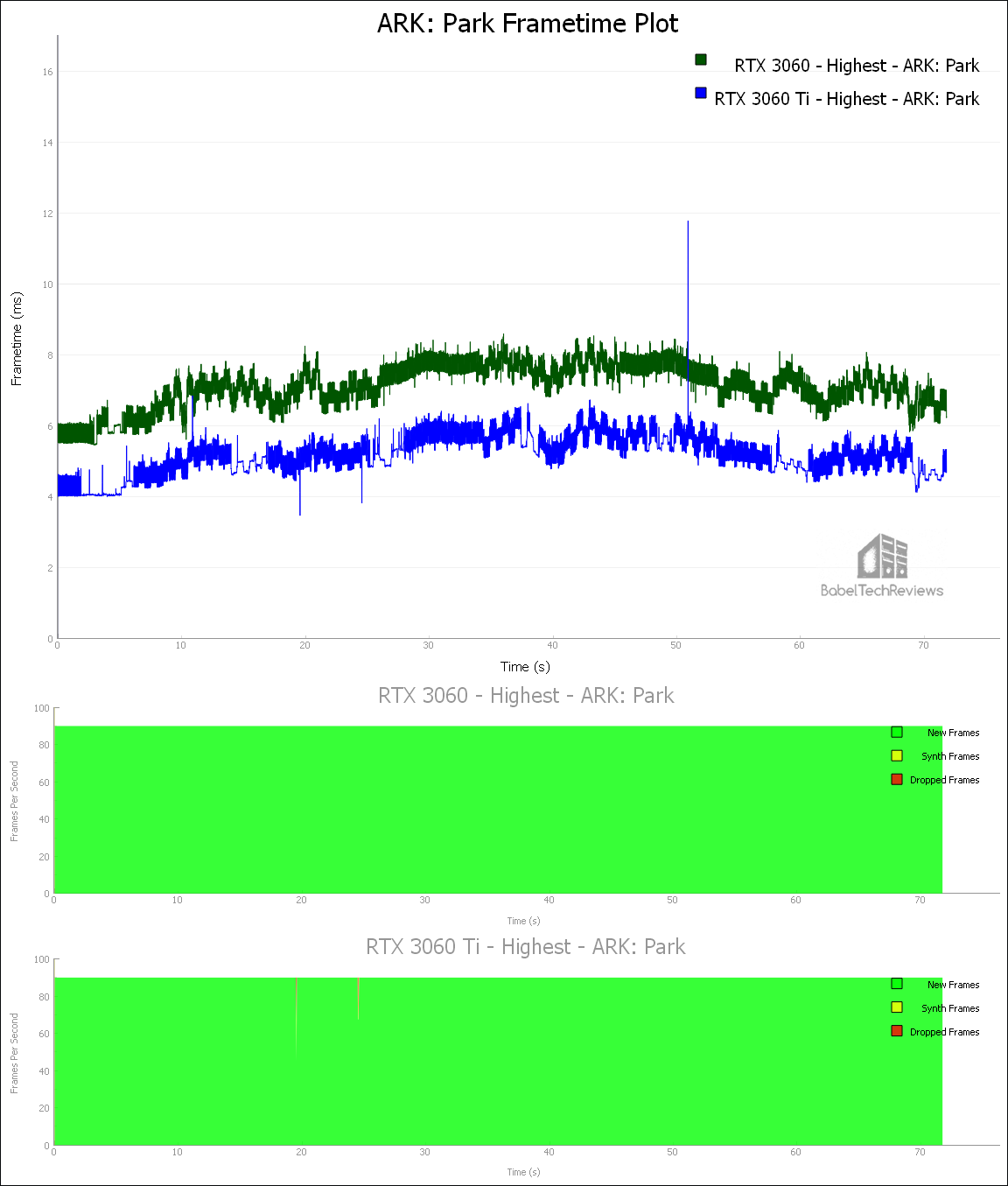
Here are the details are reported by FCAT-VR:
The RTX 3060 delivered 141.79 unconstrained FPS with no dropped frames and no synthetic frames nor Warp Misses.
The RTX 3060 Ti achieved 195.11 unconstrained FPS with 2 dropped and 2 synthetic frames together with 2 Warp misses.
There isn’t any difference playing on either of our cards at our chosen settings using 200% Super Resolution as ARK Park is built on the Unreal Engine and it is just not very demanding. However, the RTX 3060 Ti has significantly more performance headroom than the RTX 3060.
Next up, Assetto Corsa Competizione.
Assetto Corsa Competizione
BTR’s sim/racing editor, Sean Kaldahl created the replay benchmark run used for both the pancake game and the VR game. It is run at night with lots of geometry, and the lighting effects of the headlights, tail lights, and everything around the track adds to the feel of racing.
Just like with Project CARS, you can save a replay after a race. The CPU usage is the same between a race and its replay so it is a reasonably accurate benchmark using the Circuit de Spa-Francorchamps against 20 AI drivers.
Although iRacing may be more accurate or realistic, Assetto Corsa Competizione has some appeal because it feels more real than many other racing sims. It delivers the sensation of handling a highly-tuned racing machine driven to its edge.
Here are the VR Low frametimes.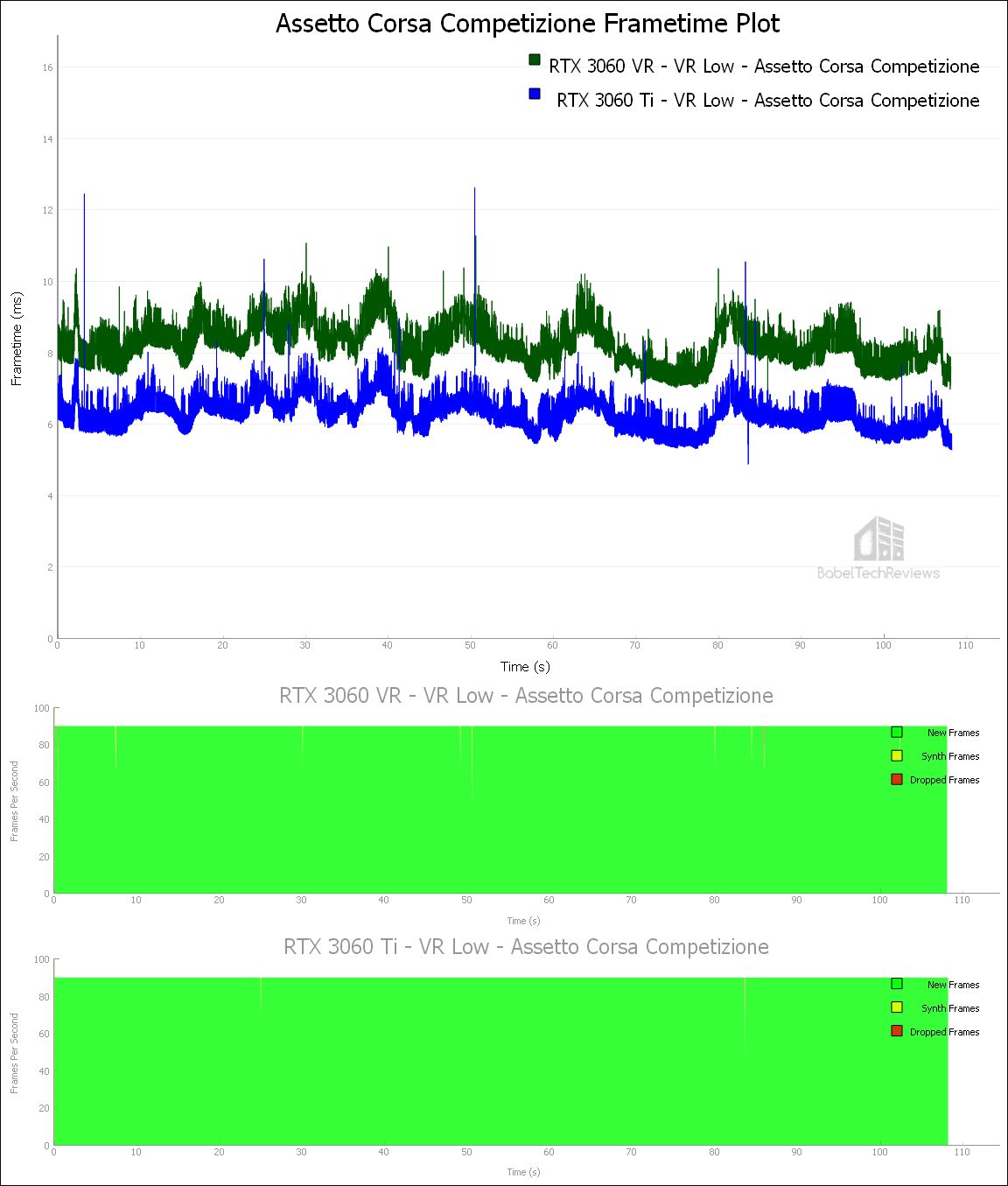
Here are the details are reported by FCAT-VR:
The RTX 3060 managed to deliver 120.20 unconstrained FPS with 2 dropped frame and 2 Warp misses, but 11 frames were synthesized.
Thee RTX 3060 Ti achieved 157.08 unconstrained FPS with 2 dropped and 2 synthetic frames together with 2 Warp misses.
The RTX 3060 Ti would be able to play on VR High if you are willing to put up with synthetic frames, but not the RTX 3060.
VR Low shows a noticeable drop in visuals from VR High, and we would suggest lowering individual settings instead of dropping from the High to Low preset to stay out of reprojection. Unfortunately, there is no “VR Medium” preset.
Next, we look at Boneworks.
Boneworks
Boneworks is a rare game that couples a fair single player campaign with an incredible sandbox and next generation VR physics interactive tour de force. We benchmark using the ‘Time Tower’ level.
Boneworks made on the Unity engine has average to very good visuals and it particularly benefits by allowing for high levels of MSAA up to 8X which we use for benching. We also enable ambient occlusion and use the highest settings, and we leave SteamVR’s resolution at 100%.
Here are the frametimes plots of both of our cards.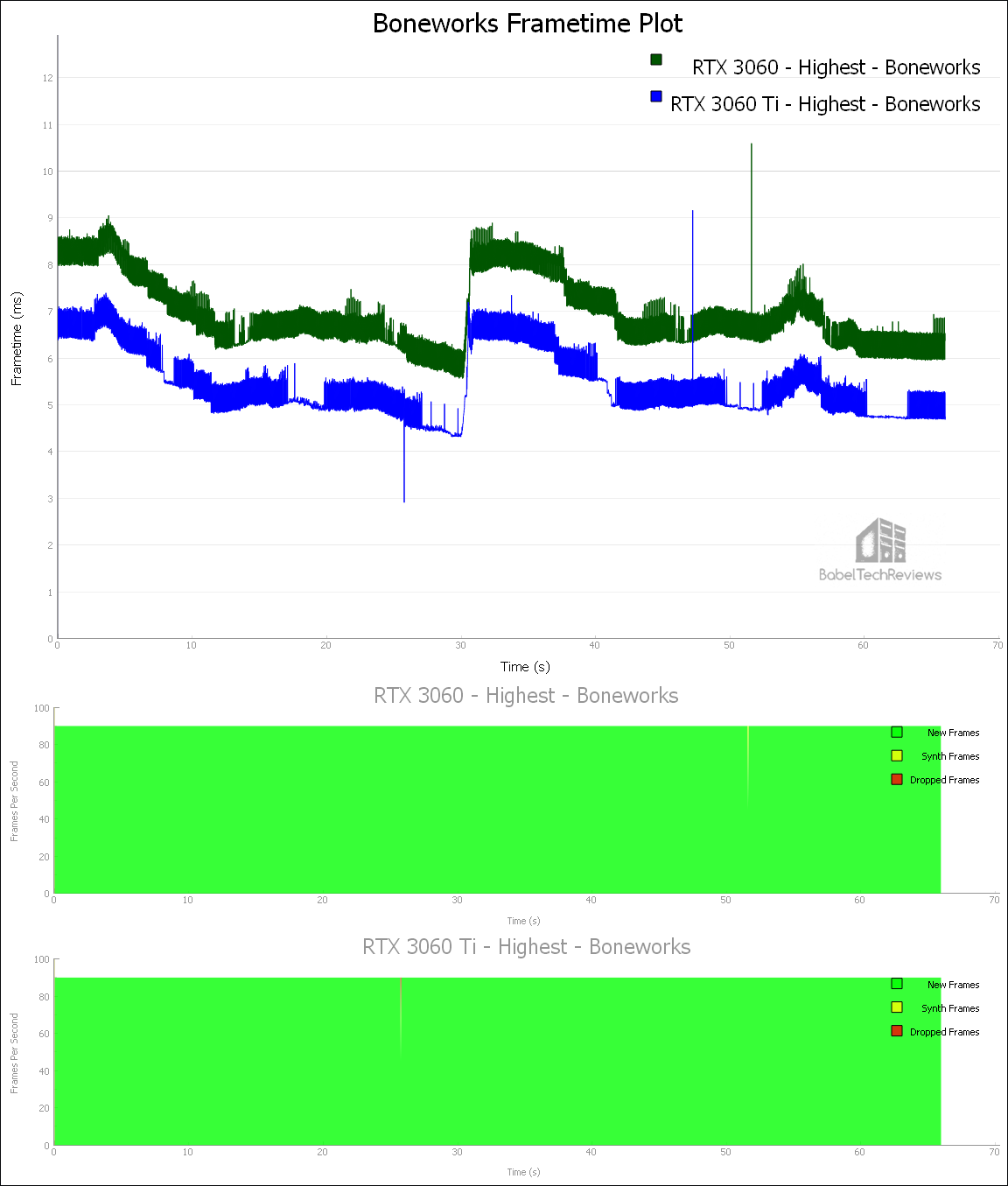
Here are the details are reported by FCAT-VR:
The RTX 3060 delivered 144.04 unconstrained FPS with no dropped frame or Warp misses, but 2 frames were synthesized.
The RTX 3060 Ti achieved 186.04 unconstrained FPS with 1 dropped frame, 1 synthetic frame, and 1 Warp miss.
As with ARK Park, there isn’t any difference playing with either cards at the highest settings at 100% resolution although the RTX 3060 Ti has more performance headroom for increasing the resolution. For GeForce cards, we recommend using VRSS for additional visual improvement with only a minor performance penalty.
Let’s check out Elite Dangerous next.
Elite Dangerous
Elite Dangerous is a popular space sim built using the COBRA engine. It is hard to find a repeatable benchmark outside of the training missions.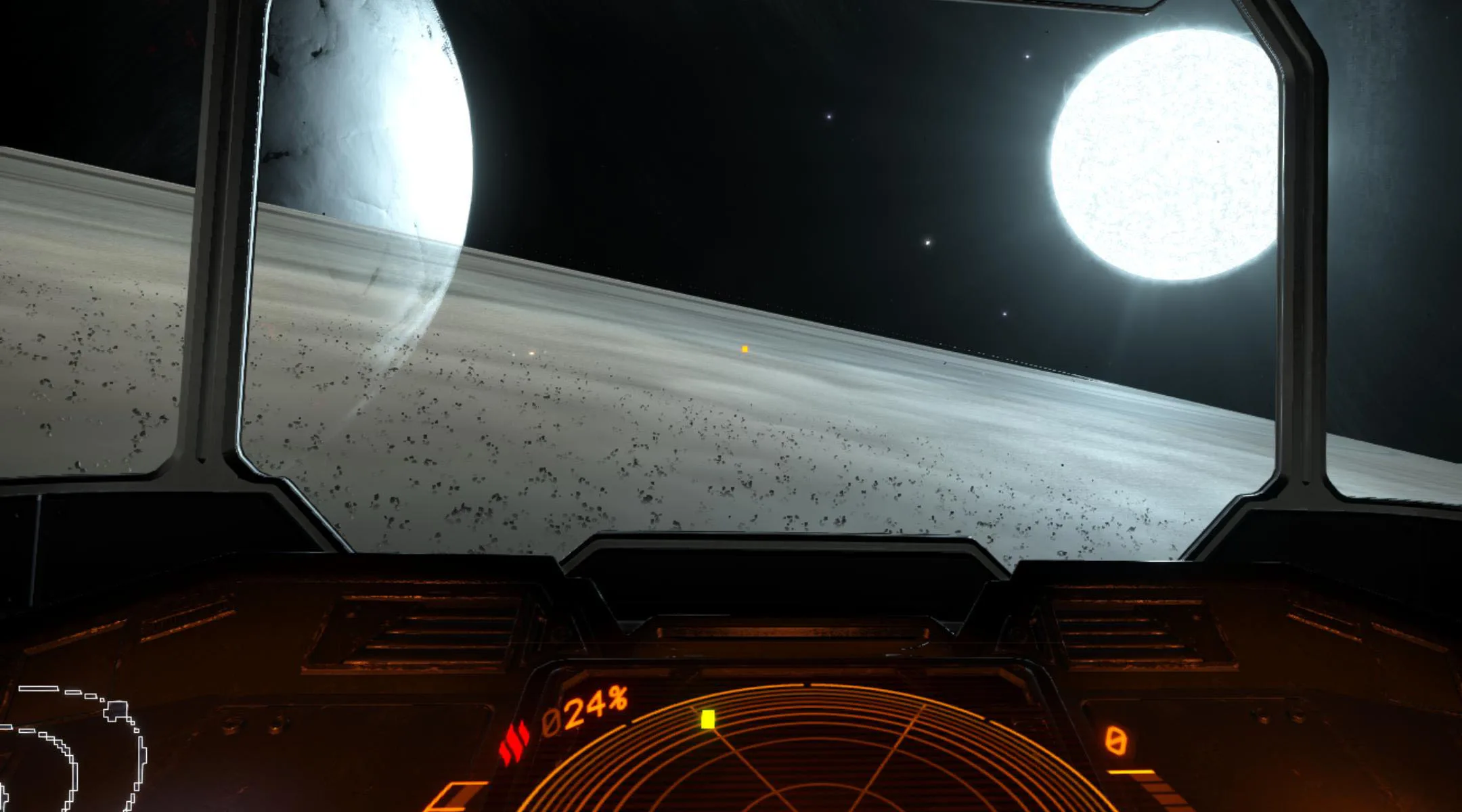
A player will probably spend a lot of time piloting his space cruiser while completing a multitude of tasks as well as visiting space stations and orbiting a multitude of different planets (~400 billion). Elite Dangerous is also co-op and multiplayer with a very dedicated following of players.
We picked the Ultra Preset and we set the field of view (FoV) to its maximum. Here are the frametimes.
Here are the details are reported by FCAT-VR:
The RTX 3060 delivered 74.37 unconstrained FPS with 2 dropped frames and 2 Warp misses, but 3217 (50%) of its frames were synthesized.
The RTX 3060 Ti delivered 105.16 unconstrained FPS with 1 dropped frame and 1 Warp miss, and 610 (9%) of its frames were synthesized.
It is perhaps acceptable to play when less than 10% of the frames are synthetic, but others may wish to lower the FoV or adjust individual settings to avoid any Motion Smoothing/Reprojection.
The RTX 3060 Ti requires less than 10% of its frames be synthesized to deliver smoothly at exactly 90Hz/FPS to the HMD while the RTX 3060 requires half of them to be synthesized. We would not play Elite Dangerous using Ultra settings using the RTX 3060.
Let’s continue with Fallout 4.
Fallout 4
Fallout 4 uses the Creation Engine, and Bethesda has dropped all support for it so it remains unoptimized although there are mods that may be helpful. It’s pretty hard to use the Index controllers with it, so we use the Vive wands instead for this game. We benchmark at its highest settings and with TAA. All Fade settings are set to their maximums.
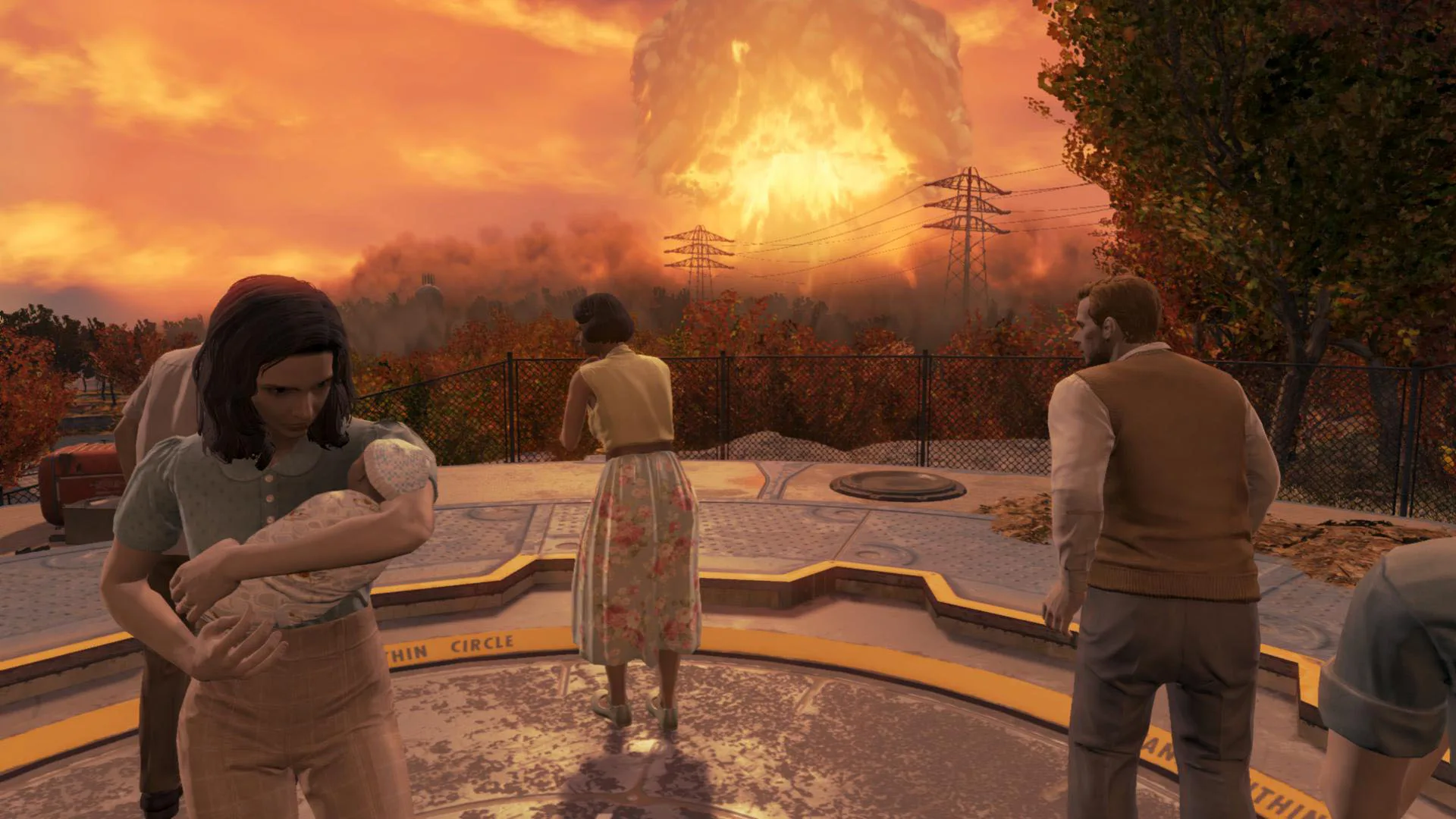 Fallout 4 had some issues on both cards as it is still an unoptimized mess abandoned by its publisher – but it is playable and an amazing full-game experience.
Fallout 4 had some issues on both cards as it is still an unoptimized mess abandoned by its publisher – but it is playable and an amazing full-game experience.
Here is the frametime plot for Fallout 4.
Here are the details are reported by FCAT-VR:
The RTX 3060 delivered 71.17 unconstrained FPS with no dropped frames and no Warp misses, but 2922 (50%) of its frames were synthesized.
The RTX 3060 Ti managed 107.76 unconstrained FPS with 2 dropped frames and two Warp misses, but 1859 (27%) of its frames were synthesized.
These cards may both benefit by using lowered settings for a smoother experience.
Next we look at Half Life: Alyx:
Half Life: Alyx
Half Life: Alyx uses an adaptive/dynamic scaling algorithm which uses a card’s performance headroom to subsample in demanding scenes and to supersample in less demanding scenes. We used its console commands to lock the SteamVR resolution to 100% so that it did not supersample or subsample.
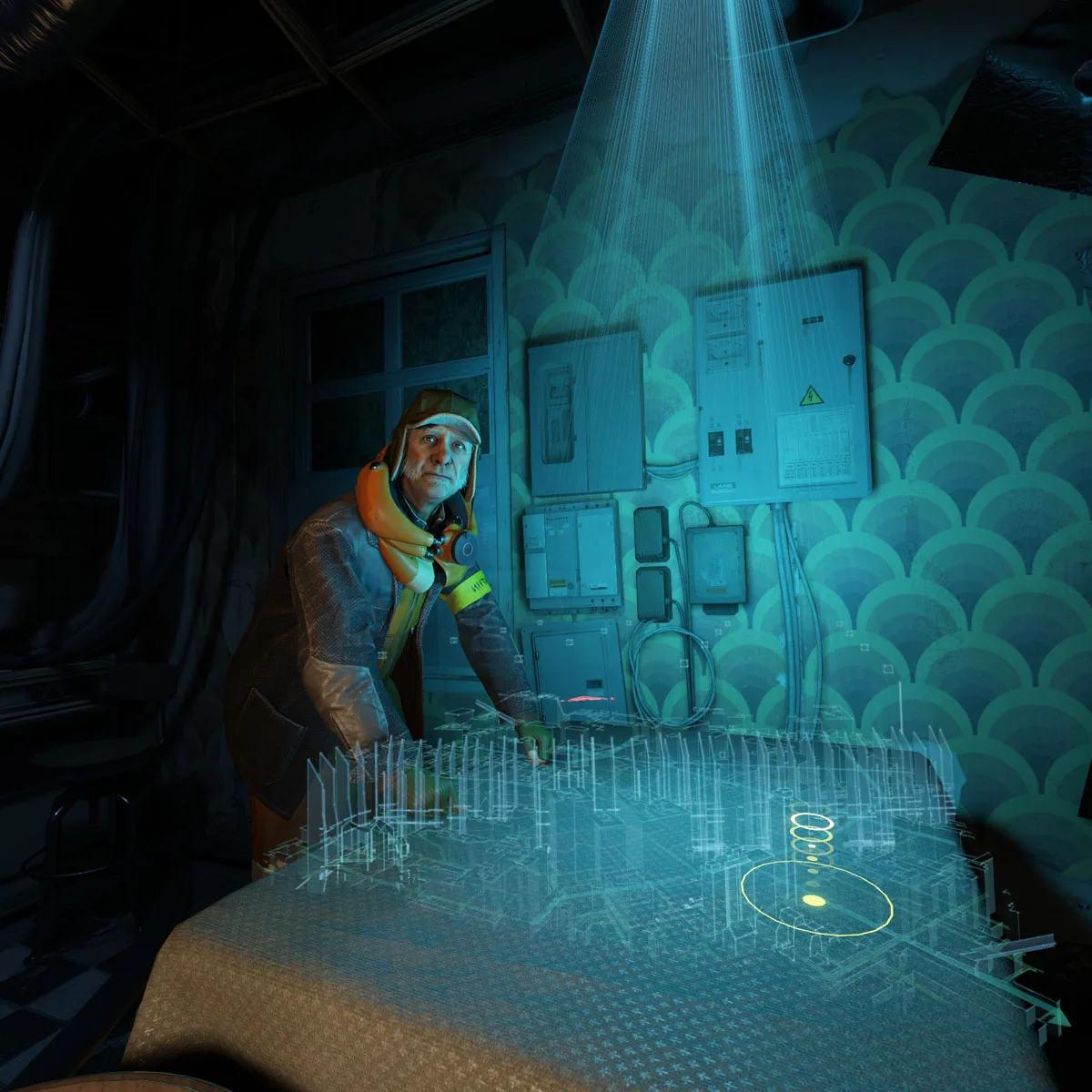 Here is the frametime plot for Half Life Alyx.
Here is the frametime plot for Half Life Alyx.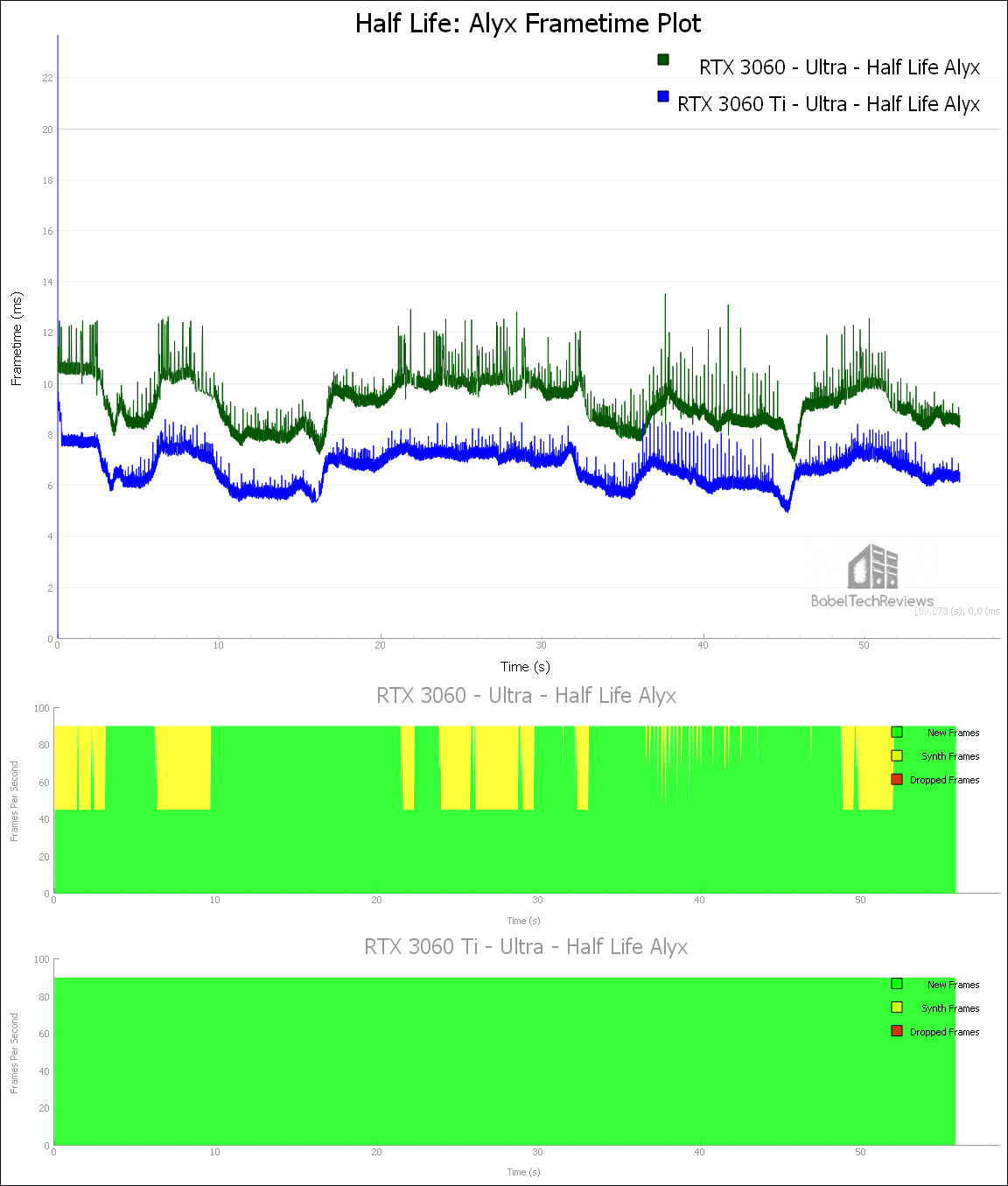
Here are the details as reported by FCAT-VR.
The RTX 3060 delivered 109.21 unconstrained FPS with no dropped frames nor Warp misses, but 763 (15%) of its frames were synthesized.
The RTX 3060 Ti managed 149.86 unconstrained FPS with no dropped, synthetic, or Warp misses.
Half Life: Alyx isn’t particularly demanding unless the Super Resolution increased in SteamVR settings, but unless console commands are used, the game will automatically subsample or supersample as needed and it will run fine with Ultra settings on both cards.
Next, we look at Hellblade: Senua’s Sacrifice.
 Hellblade: Senua’s Sacrifice
Hellblade: Senua’s Sacrifice
Hellblade: Senua’s Sacrifice is a visually impressive game built using the Unreal 4 engine. It is a dark and disturbing game that is far more intense in VR than the pancake version. We benchmark at 100% resolution with its very highest in-game settings and with TAA.
Here is the frametime plot for Hellblade: Senua’s Sacrifice.
The RTX 3060 delivered 98.26 unconstrained FPS with 4 dropped frames and 4 Warp misses, but 1230 (19%) frames were synthesized.
The RTX 3060 Ti delivered 132.2 unconstrained FPS with no dropped frames and no Warp misses, but it required 5 synthetic frames.
Hellblade looks great at 100% resolution and we would suggest lowering individual settings to stay out of reprojection for the RTX 3060 although it is possible to increase the in-game resolution to 110% or higher for the RTX 3060 Ti.
Next we look at Into the Radius.
Into the Radius
Into the Radius is a hardcore single player stealth survival adventure/exploration game, and it pays homage to the S.T.A.L.K.E.R. series by being set in the dangerous large open world of the Pechorsk Exclusion Zone. 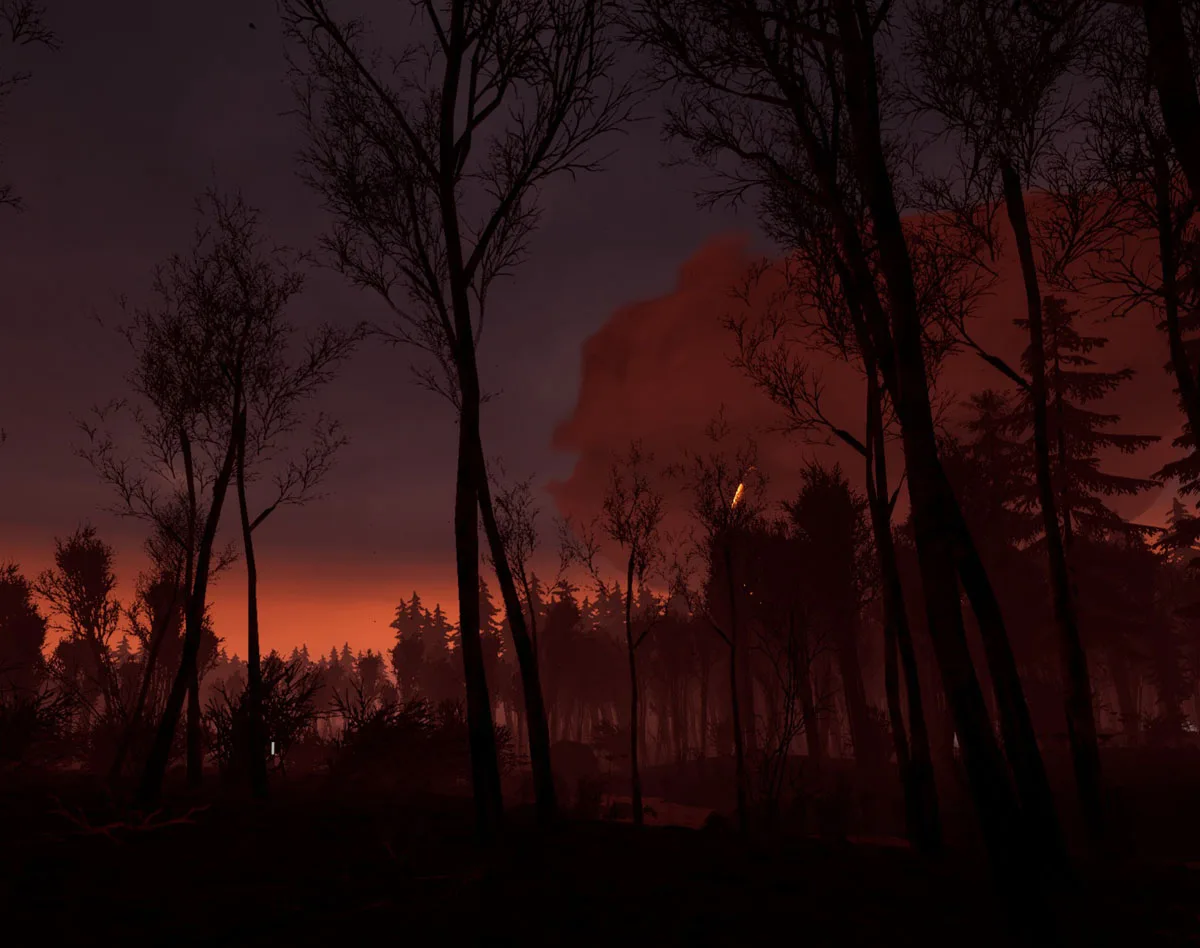
Into the Radius has decent visuals using Unreal Engine 4 that really add to its spooky and intense atmosphere, and its performance demands on the video card are also higher since its a huge open world game with a decent draw distance.
There are no user options for changing individual graphics settings other than High, Medium, and Low presets. There is also a slider to drop or subsample the resolution down to 65%, or to increase the resolution to 110%. We benchmarked our two cards at High Quality and with 100% resolution.
Here is the frametime plot for Into the Radius.
The RTX 3060 managed 108.06 unconstrained FPS with no dropped frames or Warp misses, but 130 (2%) frames were synthesized.
The RTX 3060 Ti produced 157.21 unconstrained FPS with no dropped frames and no Warp misses but 11 synthetic frames were generated.
The RTX 3060 provided a similar VR experience playing Into the Radius as using the RTX 3060 Ti which offers enough performance headroom to increase the resolution to 110%.
Next, we will check out another demanding VR game, No Man’s Sky.
No Man’s Sky
No Man’s Sky is an action-adventure survival single and multiplayer game that emphasizes survival, exploration, fighting, and trading. It is set in a procedurally generated deterministic open universe, which includes over 18 quintillion unique planets using its own custom game engine.
The player takes the role of a Traveller in an uncharted universe by starting on a random planet with a damaged spacecraft equipped with only a jetpack-equipped exosuit and a versatile multi-tool that can also be used for defense. The player is encouraged to find resources to repair his spacecraft allowing for intra- and inter-planetary travel, and to interact with other players.
Here is the No Man’s Sky Frametime plot. We set the settings to Enhanced which is above Low and below High, but we also set the anisotropic filtering to 16X and upgraded to FXAA+TAA.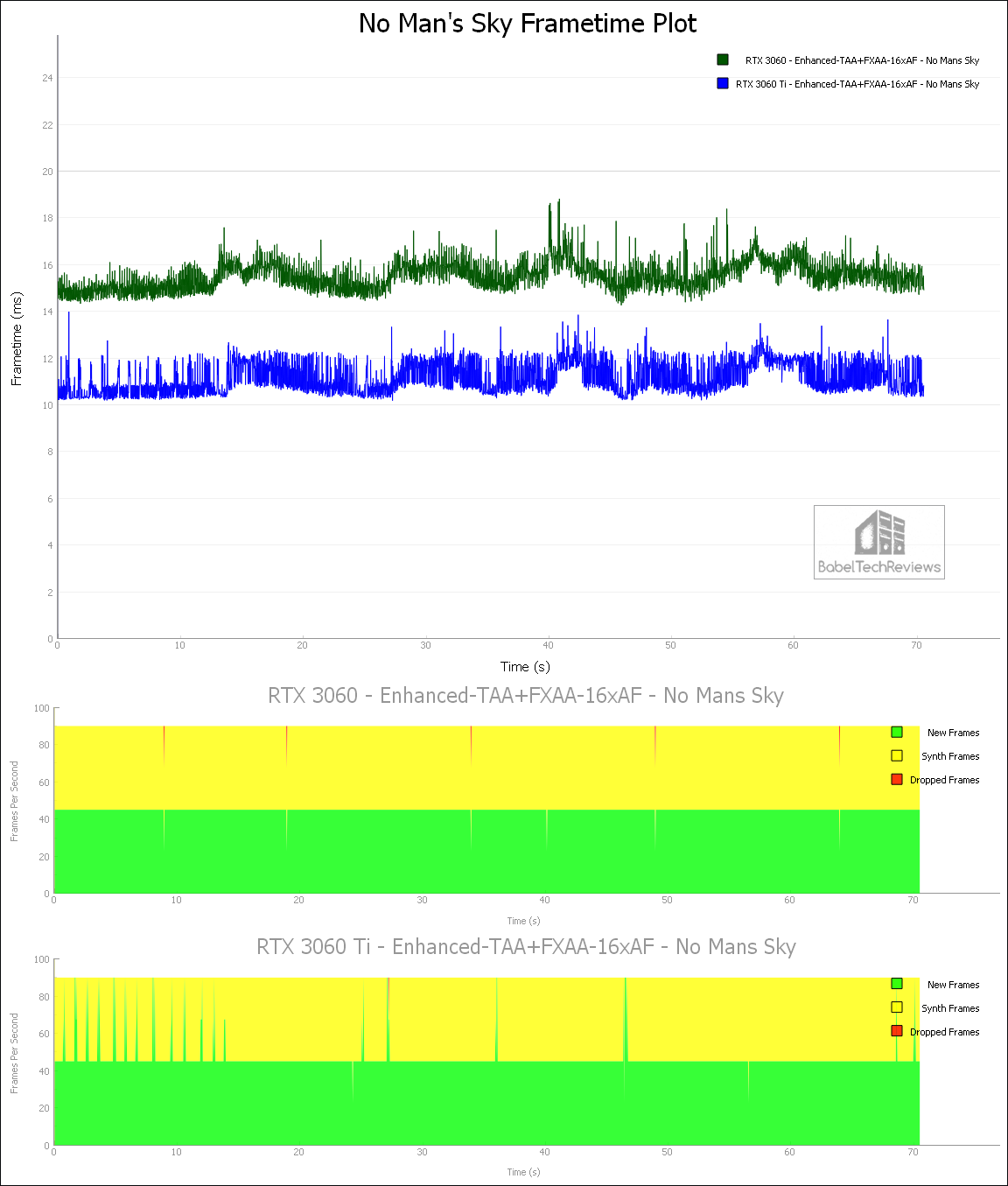
Here are the FCAT-VR details of our comparative runs.
The RTX 3060 delivered 64.35 unconstrained FPS with 5 dropped frames and 5 Warp misses, but 3179 (50%) frames were synthesized.
The RTX 3060 Ti produced 89.60 unconstrained FPS with 1 dropped frames and 1 Warp miss, but it required 3079 (48%) synthetic frames.
The Low Preset may be better suited for both cards or else individual setting may be lowered to maintain a balance of performance to visuals.
Next, we will check out another VR game, Obduction.
Obduction
Obduction is considered to be the spiritual successor to Myst and Riven. It is an adventure game developed by Cyan Worlds using the Unreal 4 engine and it has very good visuals. There is an emphasis on puzzle solving which get more and more difficult as a player progresses.
Obduction’s visuals are both graphically impressive and relatively intensive. There are adjustable menu sliders that will allow the player to dial down the settings but we picked Epic and left the in-game resolution at 100% plus 75% texture memory. Lowering the settings means the world textures are less detailed and the player will see them pop into view rather suddenly, breaking VR immersion.
Here is Obduction’s frametime plot.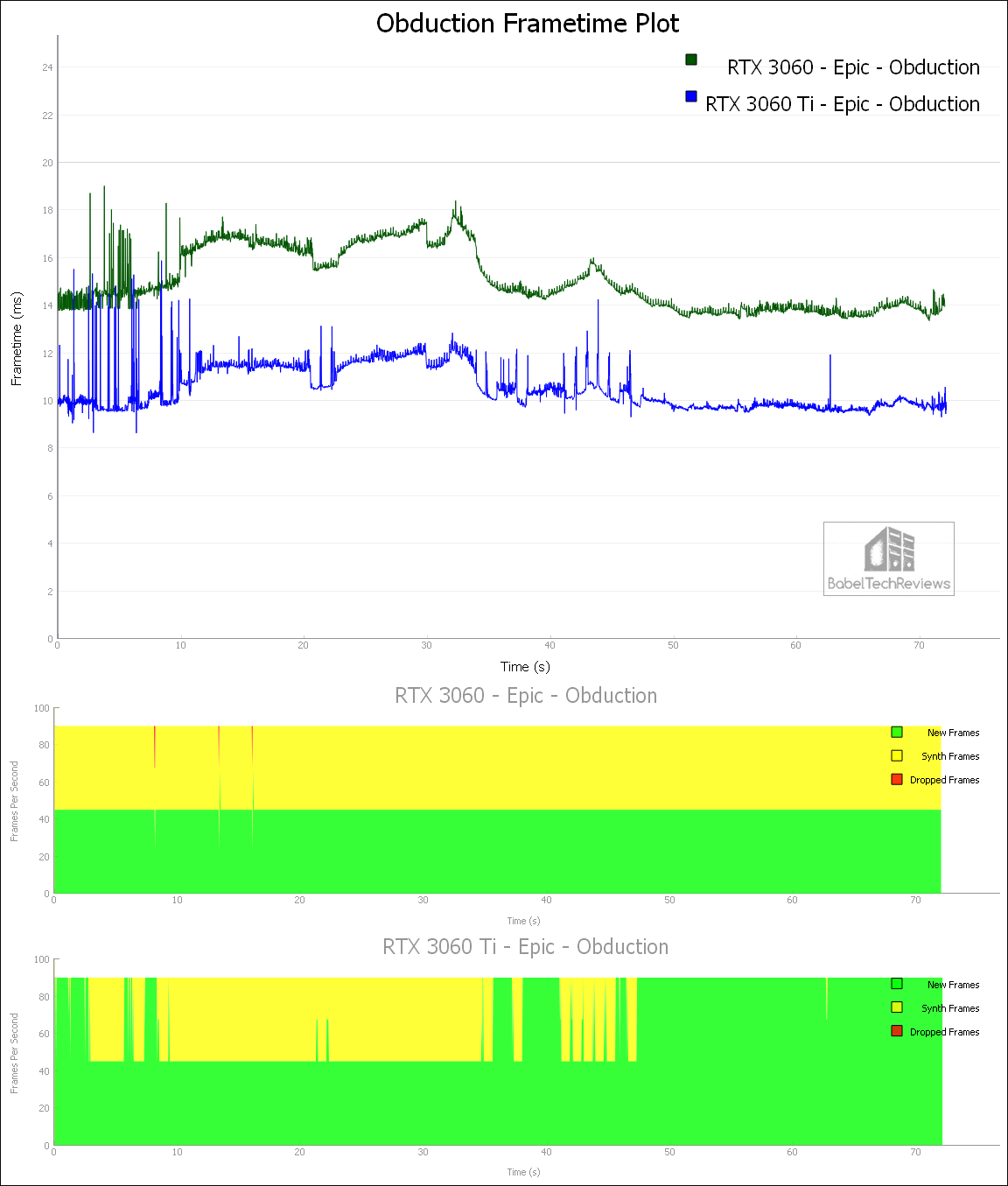
The RTX 3060 delivered 66.46 unconstrained FPS with 4 dropped frames and 4 Warp misses, and 3241 (50%) frames were synthesized.
The RTX 3060 Ti delivered 96.83 unconstrained FPS with no dropped frames or Warp misses but 1643 (25%) synthetic frames were generated.
The RTX 3060 Ti delivers a better VR experience than the RTX 3060 although we would not recommend playing with all Epic individual settings even at 100% resolution.
Next we check out BTR’s newest game, Pavlov.
Pavlov
There is a real sense of immersion that comes from playing Pavlov in VR. Pavlov is the most popular multiplayer shooter in VR with a primary focus on its community. Realistic fast-paced combat is a large part of its core experience, and even tanks have been added to make it into a great shooter.

We used the training sessions with the highest settings.
The RTX 3060 delivered 168.74 unconstrained FPS with no dropped frames or Warp misses.
The RTX 3060 Ti delivered 232.77 unconstrained FPS also with no dropped frames or Warp misses.
The RTX 3060 delivers an identical VR experience to the Ti although the faster card has significantly more performance headroom that may be used for increasing the resolution.
Next we will check out another demanding VR game, Project CARS 2 that we like better than Project CARS 3.
Project CARS 2
There is a real sense of immersion that comes from playing Project CARS 2 in VR using a wheel and pedals. It uses its in-house Madness engine, and the physics implementation is outstanding. We are disappointed with Project CARS 3, and will continue to use the older game instead for VR benching.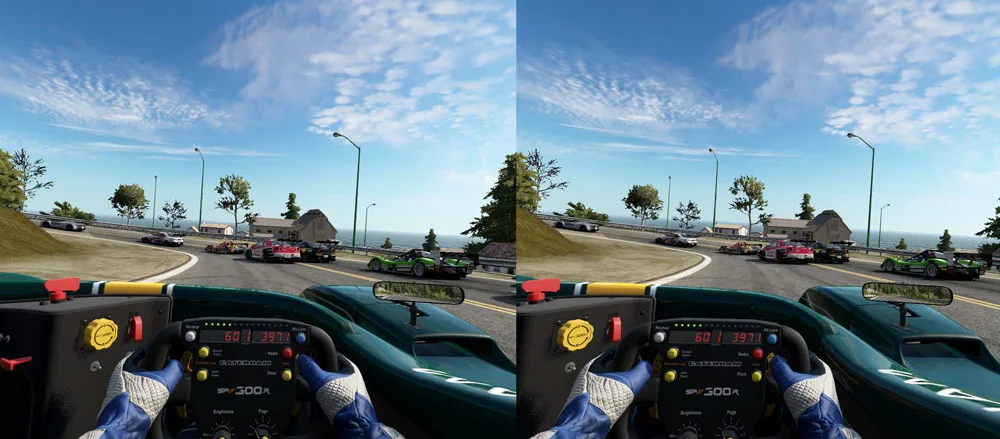
Project CARS 2 offers many performance options and settings and we prefer playing with SMAA Ultra.
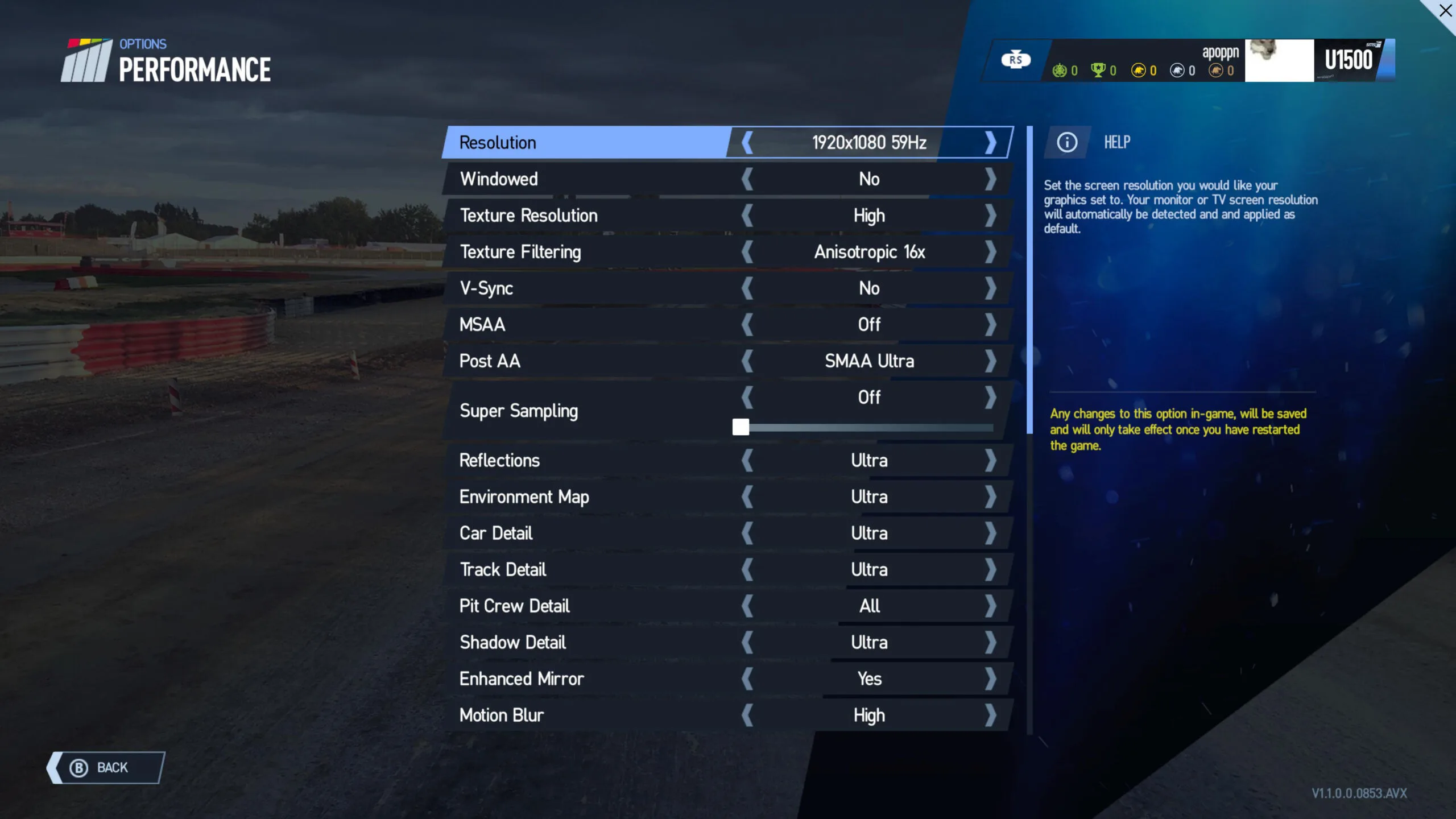
We used maximum settings including for Motion Blur although it looks best to us on Low or Medium. For lesser cards, we would also recommend lowering grass and reflections to maximize framerate delivery as motion smoothing or reprojection tends to cause visible artifacting.
The RTX 3060 managed 61.00 unconstrained FPS with 1 dropped frame and 1 Warp miss but 4793 (50%) frames were synthesized.
The RTX 3060 Ti achieved 77.43 unconstrained FPS with no dropped frames but with 4792 (50%) synthetic frames. It had no Warp misses.
The experience playing Project CARS 2 on our maximum VR settings is similar on both cards, but we would recommend lowering individual settings or even lower the resolution a bit as needed to stay out of reprojection.
Let’s benchmark Skyrim VR.
Skyrim VR
Skyrim VR is an older game that is no longer supported by Bethesda, but fortunately the modding community has adopted it. It is not as demanding as many of the newer VR ports so its performance is still very good on maxed-out settings using its Creation engine.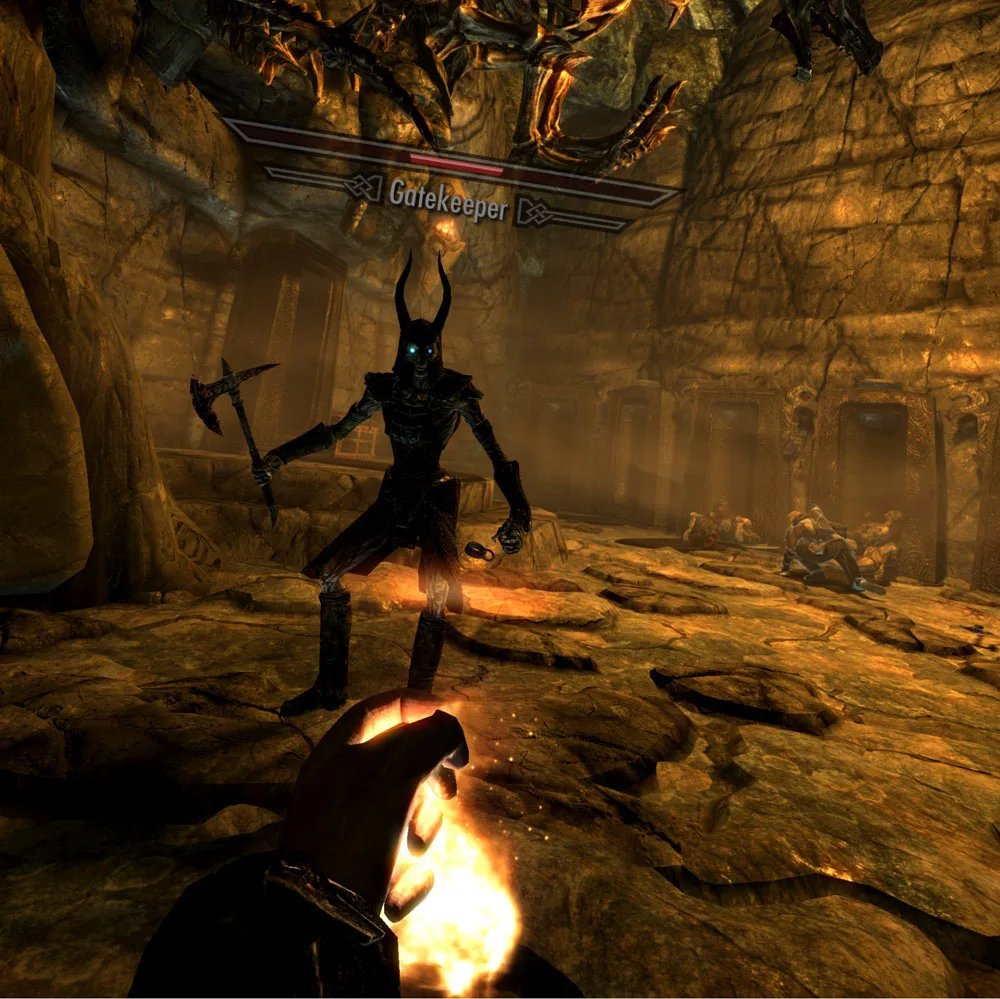
We benchmarked Skyrim VR using its highest settings, and we also increased the resolution to its in-game maximum.
Here are the frametime results.
Here are the details of our comparative runs as reported by FCAT-VR.
The RTX 3060 delivered 105.14 unconstrained FPS with 4 dropped frames and 4 Warp misses, and 2196 (24%) frames were synthesized.
The RTX 3060 Ti managed 124.266 unconstrained FPS with 6 dropped frames, 51 synthetic frames, and 6 Warp misses.
Only the RTX 3060 Ti can play Skyrim at its maxed out in-game settings including using maximum in-game Supersampling without resorting to reprojecting or synthesizing frames.
Let’s check out Subnautica next.
Subnautica
Subnautica uses the Unity engine. As the sole survivor of a crash landing, the player ventures into the depths of a visually impressive alien underwater world. Here you can explore, craft equipment and build bases, pilot underwater craft, and solve mysteries all while attempting to survive a hostile environment. It is an unoptimized mess, but the VR experience is well worth it.
We benchmarked Subnautica using its highest settings plus TAA, but we left its resolution at 100%, and here are the frametime results.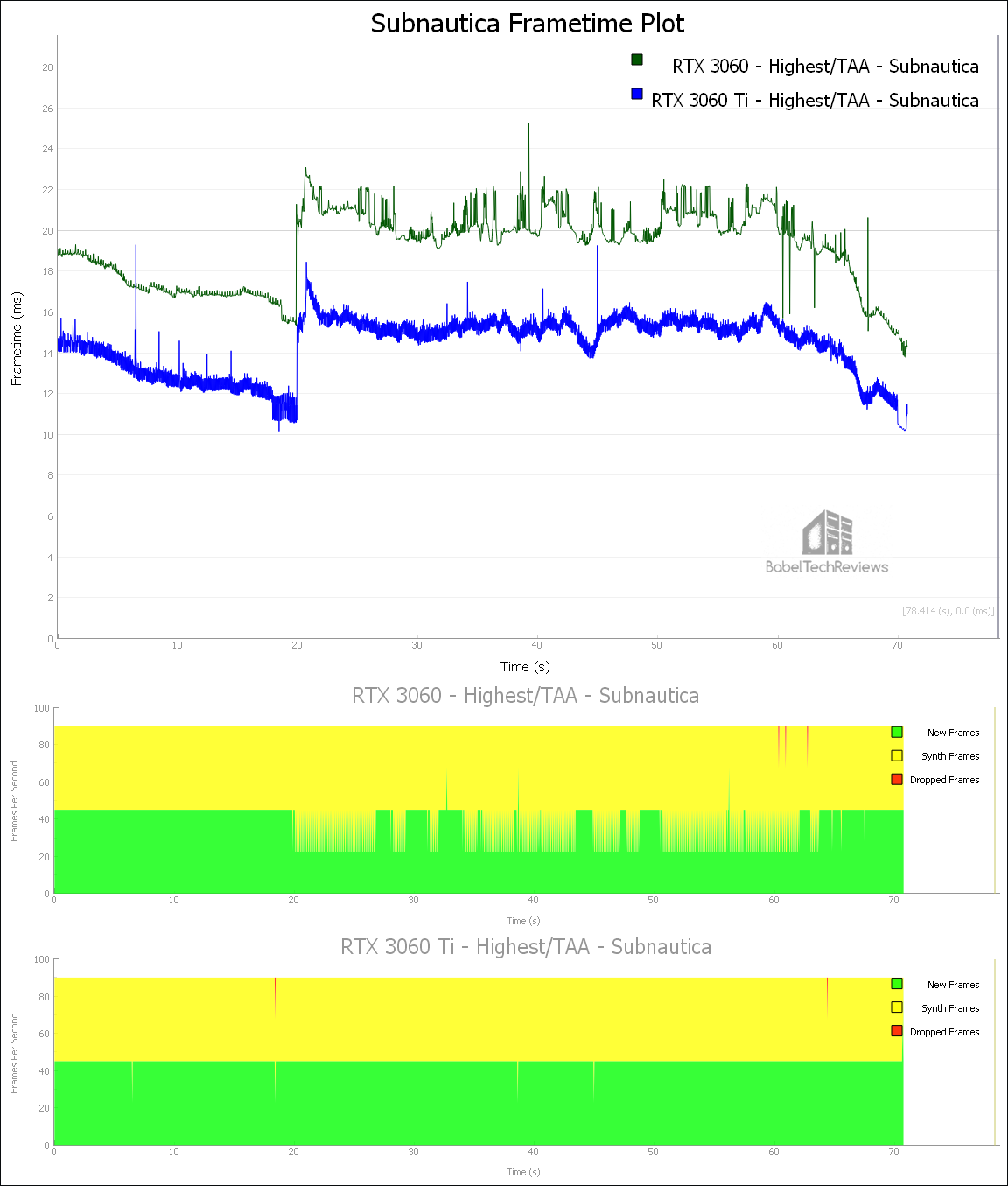 Here are the details.
Here are the details.
The RTX 3060 managed 52.85 unconstrained FPS with 3 dropped frames and 3 Warp misses, but 3675 (58%) frames were synthesized.
The RTX 3060 Ti achieved 69.47 unconstrained FPS with 2 dropped frames and 2 Warp misses, but 3187 (50%) frames needed to be synthesized.
The experience playing Subnautica using its highest settings is not great as it doesn’t appear to be very well optimized, and there are obvious stutters at times We would recommend lowering individual settings as needed to maintain a balance between visuals and performance to stay out of reprojection.
Next up, The Vanishing of Ethan Carter.
The Vanishing of Ethan Carter
The Vanishing of Ethan Carter is an older game which is built on the Unreal 4 engine and it still boasts amazing visuals although it is not demanding. Although it is considered by some to be a walking simulator, it is also an excellent detective game with great puzzles. But be aware that its style of locomotion tends to make some of its players VR sick.
There are only a few in-game graphics options available, so we used 100% resolution in-game with TAA.
Here are the FCAT-VR details at 100% Resolution.
The RTX 3060 delivered 132.88 unconstrained FPS with no dropped frames or Warp misses, and no frames were synthesized.
The RTX 3060 Ti managed 183.30 unconstrained FPS with 2 dropped frames, 2 synthetic frames, and 2 Warp misses.
Although it is a beautiful game visually, The Vanishing of Ethan Carter isn’t particularly demanding. The VR experience playing on both cards are similar.
Last up, The Walking Dead: Saints & Sinners.
The Walking Dead: Saints & Sinners
 The Walking Dead: Saints & Sinner is the last of BTR’s 16 VR game benching suite. It is a first person survival horror adventure RPG with a strong emphasis on crafting. Its visuals using the Unreal 4 engine are outstanding and it makes good use of physics for interactions.
The Walking Dead: Saints & Sinner is the last of BTR’s 16 VR game benching suite. It is a first person survival horror adventure RPG with a strong emphasis on crafting. Its visuals using the Unreal 4 engine are outstanding and it makes good use of physics for interactions.
We benchmarked Saints and Sinners using its highest settings and we left the Pixel Density at 100%.. 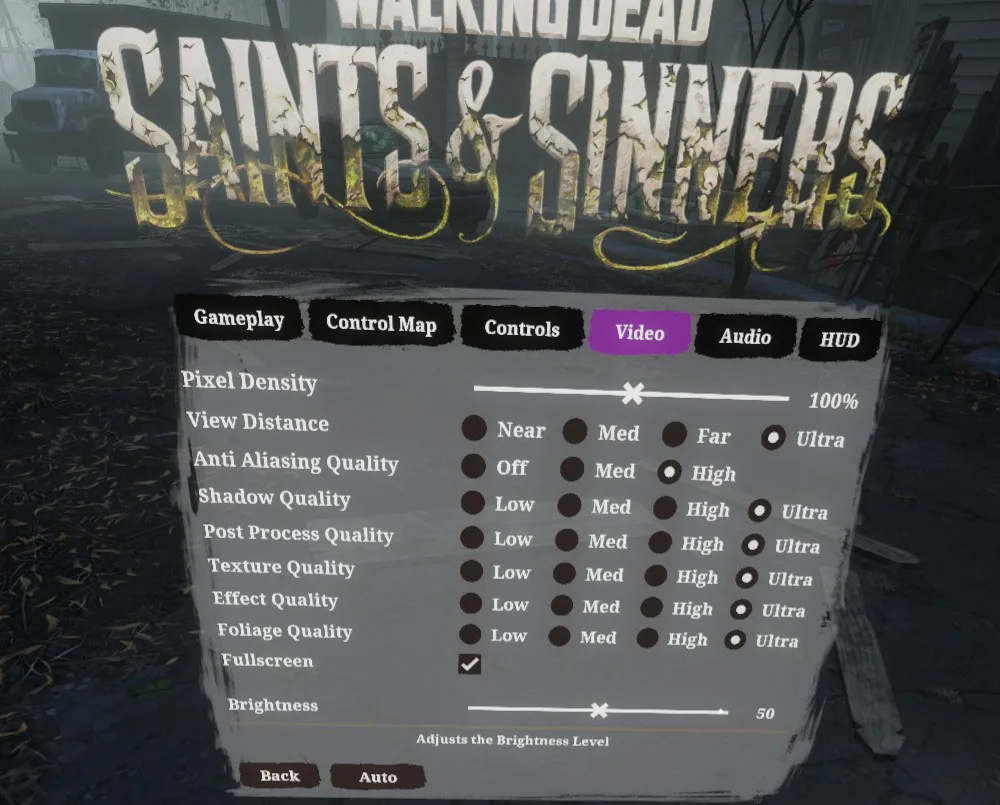 Here is the frametime chart. Please note that the Pixel Density is 100%.
Here is the frametime chart. Please note that the Pixel Density is 100%.
Here are the details as reported by FCAT-VR. Please note that the Pixel Density is 100%.
The RTX 3060 produced 111.87 unconstrained FPS with 2 dropped frames and 2 Warp misses, but 344 (5%) frames were synthesized.
The RTX 3060 Ti managed 146.53 unconstrained FPS with 2 dropped frames and 2 Warp misses but only 3 synthetic frames were generated.
Playing The Walking Dead: Saints & Sinners using the in-game maximum settings and 100% Pixel Density is similar for both of our cards although the RTX 3060 Ti has sufficient headroom to not require synthetic or reprojected frames.
Unconstrained Framerates
 The following chart summarizes the overall Unconstrained Framerates (the performance headroom) of our two cards using sixteen test games and and we added the RX 5700 XT for three synthetic benches: Superposition, VRMark’s Blue Room, and the OpenVR benchmark. Higher is better. Synthetic benchmarks are only useful for ranking cards. They don’t predict how any game will actually play in VR on any particular video card.
The following chart summarizes the overall Unconstrained Framerates (the performance headroom) of our two cards using sixteen test games and and we added the RX 5700 XT for three synthetic benches: Superposition, VRMark’s Blue Room, and the OpenVR benchmark. Higher is better. Synthetic benchmarks are only useful for ranking cards. They don’t predict how any game will actually play in VR on any particular video card.
We don’t give percentages of change or percentages of increase between competing cards since unconstrained framerates are just one metric of performance headroom that is useless without the accompanying frametime charts.
Let’s check out our conclusion.
Conclusion
Unfortunately, we are facing two pandemics – the COVID-19 pandemic and the Cryptocurrency Pandemic – both of which have made it very difficult for gamers to find any new cards at all – and pricing is way up primarily because of the mining demand. If the EVGA RTX 3060 can be purchased for its suggested price of $329, it would be an acceptable entry level card for the Vive Pro or Valve Index class of VR headset. However, the RTX 3060 Ti probably gives the most bang-for-buck for VR at $399.
It is great to see NVIDIA delivering two cards that are below $400 – if they can be found – that drop the entry price for VR. It will also be interesting to see what AMD brings to this price segment with their upcoming midrange RX 6000 Navi 3 cards.
The EVGA RTX 3060 Black sits in a unique position as the fastest $329 MSRP video card available for VR and it offers reasonable performance for use with a HMD like the Vive Pro or the Valve Index, and no doubt it would offer excellent performance for an original Vive, Rift CV1, or even for a Rift S.
The RTX 3060 can max out several of the games in our benching suite if the resolution is left at 100% or slightly subsampled, or if the in-game settings are lowered. But if someone is going to spend $1000 for a premium HMD, it makes sense to pair it with a faster video card like the RTX 3060 Ti or higher. However, one cannot pair a high resolution headset like the Reverb G2 with either card.
The RTX 3060 is a good card for high/medium quality PC VR at a rather bargain price of $329 – if it can be purchased at this price – and the RTX 3060 Ti is a more solid offering for $70 more. The RTX 3070 is faster but it also costs $170 more at $499 and the RX 6800 costs $258 more and is also almost impossible to find. The EVGA RTX 3060 Black is impressive as a $329 card that can even power a high-end HMD and its a real step forward toward more widespread VR adoption.
Next up for today is the much more detailed Part 2 of our Mega 53-game review using 37 pancake games, GPGPU, workstation, SPEC, and synthetic benchmarks comparing the new EVGA RTX 3060’s performance with the RTX 3060 Ti, the RTX 2060, the GTX 1060, and against the Radeon RX 5700 XT. Don’t miss it!
Stay tuned to BTR!
Happy VR Gaming!
